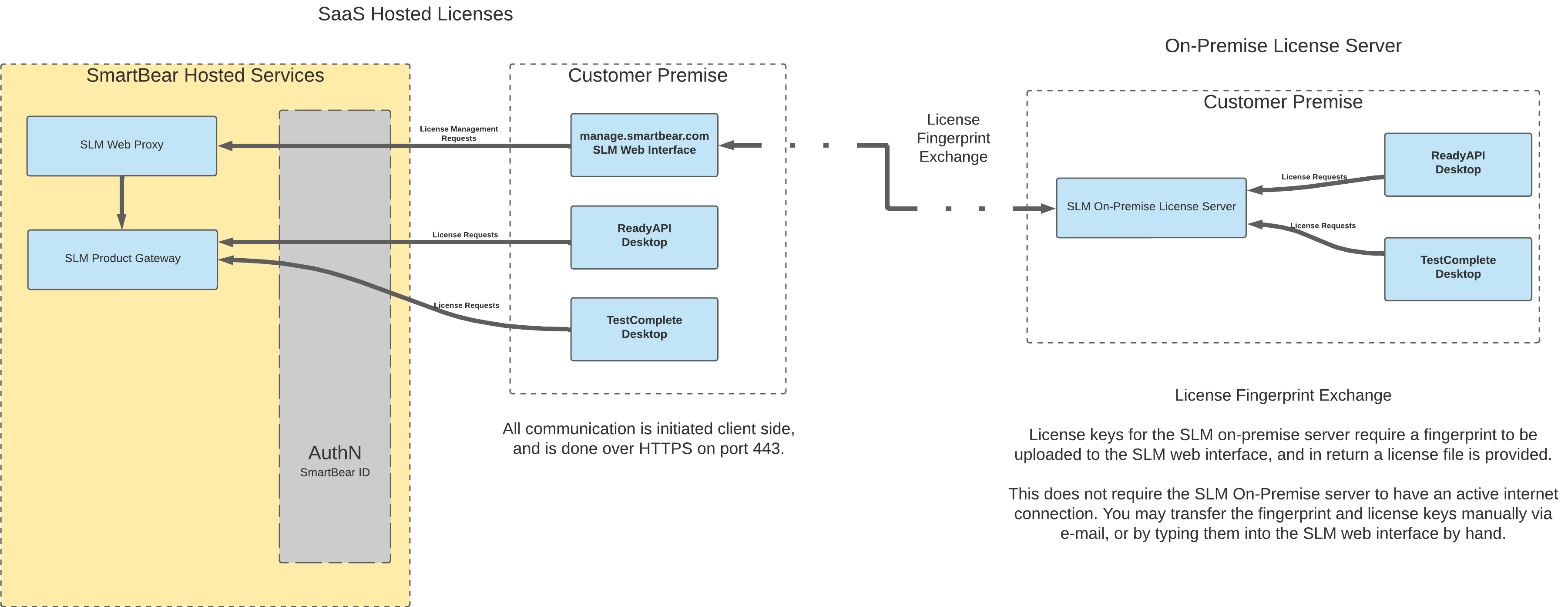About
Introduction to SmartBear License Management?
The following video gives an introduction to SmartBear License Management:
Note
SmartBear License Management is used by the following on-premise products only: ReadyAPI, TestComplete, TestEngine, VirtServer, TestExecute, and TestLeft. For licensing information about any other SmartBear product, see SmartBear Support.
For information about Swagger subscriptions, see SmartBear Admin.
Requirements
SmartBear license servers
The computer where your SmartBear product will run needs a connection to the SmartBear license servers:
 https://manage.smartbear.com:443 |
 https://api.slm.manage.smartbear.com:443 |
 https://login.slm.manage.smartbear.com:443 |
 https://server.manage.smartbear.com:443 |
 https://server.slm.manage.smartbear.com:443 |
 https://profile.id.smartbear.com:443 |
 https://profile-api.id.smartbear.com:443 |
 https://auth.id.smartbear.com:443 |
Proxies and firewalls running in your network should allow access to these addresses. If needed, ask your network administrators for assistance in configuring the proxies and firewalls.
This access is needed both at the product start and during the product run. The addresses are for API servers, so they don’t have a user interface that appears in browsers. When products call those hosts, they add some specific paths or URLs to the addresses.
Note
We encrypt all data at rest and over the wire.
Other considerations
By default, right after purchase, a license is not assigned to any user. The license administrator — a person who manages the licenses on your side — should assign it to a user (or users) before they run their SmartBear product. See Activate and Use Licenses.
To run the product, you need a SmartBear ID login account — an email and password combination that gives access to SmartBear portals and services. See SmartBear Administration for more information.
When a license administrator assigns a license to a user, the user will receive an email with a link to create their SBID login credentials.
License types
By default, licenses from SmartBear License Management are for machines with an active internet connection. However, to use SmartBear products within private networks, you can request conversion to an offline license. See Licensing in Private Networks for more information.
We offer Fixed User and Floating licenses. Both can have one or multiple seats:
Fixed User: The license administrator assigns seats to users, and each seat can be consumed only by the user to whom this seat is assigned.
Floating: The seats are not strictly assigned to users. The license administrator defines a group (pool) of users, and any person from this pool can use the license if a free seat is available.
One person can consume multiple seats. This happens when that person is running the product on multiple computers concurrently.
See also License Types.
Frequently Asked Questions?
Question | Answer |
|---|---|
Can I use SAML Single Sign-On (SSO) to access SmartBear License Management? | Yes, for more information on setting up SSO. See, Single Sign-On (SSO). |
Do I need to be connected to the license server during the product run? | The standard version of SmartBear License Management requires a connection both at the product start and during the run. The product exchanges information on license usage with the SmartBear license server throughout. A version for use in private networks is also available upon request, which does not need a permanent internet connection. See Licensing in Private Networks for more information. |
Does the license server store information about the machine where the product is running or about the licensed user? | The SmartBear license server has the following information:
|
What security measures are in place for License Management users? | This service is hosted on an encrypted AWS virtual private cloud. Only authorized SmartBear personnel have access to data over an encrypted VPN. All this access is logged. Users' interactions with the service, including administration and maintenance, are via encrypted communications channels and protocols. |
What will happen if the Internet connection breaks during the run? | The product will continue running. You will have up to 24 hours to restore the connection. If the connection is not restored after this time period, the product will stop running. |
What if a product did not release a license because of a crash or other error? How do I make my license available? | Just run the product again. If you do this on the computer where you’ve worked before, nothing else is needed. If you start the product on another machine, you might need to wait a few minutes for the SmartBear license server to update information on the computer being used. |
Can licenses be grouped by business unit? | Yes, license administrators can group licenses. |
Does SmartBear License Management (SLM) support service accounts? What are the considerations concerning service accounts and fixed/floating? | SmartBear License Management (SLM) cannot create service accounts within the tool. However, if a service account exists within the customer's IdP as an email address, it can be added to SLM like any other user. Keep the following in mind when using service accounts to avoid EULA violations:
For information about service accounts. See Service Accounts. |
License Management Service Diagram
License Management comprises the following components:
 |
Key
SLM - SmartBear License Management
SaaS - cloud-based version of License Management
On Premise - off-line version of License Management for floating licenses
SKUs - SmartBear products using License Management